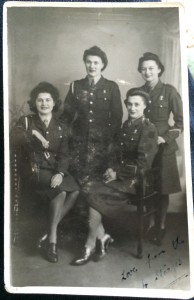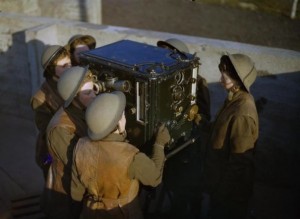Posted By Duncan ~ 24th April 2015

Jessie Denby and her comrades in 518 mixed Ack Ack battery (note their white lanyards)
Of all the ‘men’s’ jobs that women performed during the course of the war, perhaps the most dramatic and exciting was working on the Anti-Aircraft guns. It was a female engineer, Caroline Haslett, who first proposed using female gun crew, a year before the war had even started, and it didn’t take long for Winston Churchill himself to come around to the idea – as he put it, ‘A gunner is a gunner.’ In fact, one of the first to volunteer for the new trade was the Prime Minister’s own daughter Mary, who served on a gun-site in Hyde Park.
Thanks to a Royal Proclamation forbidding women from using deadly weapons, the girls selected for ‘Ack-Ack’ were assigned to new mixed-sex batteries, where they worked alongside men who actually loaded and fired the guns. The Army was careful to ensure that the male soldiers chosen for these new mixed batteries were fresh recruits rather than seasoned old sweats, who it was felt might bring more prejudices along with them. Nonetheless, the girls often had to win their new male colleagues over.
There were three main roles performed by the girls on the gun-sites. Spotters would keep an eye out for enemy planes using state of the art Bar and Stroud binoculars. Then, once a target was selected, the girls on the height-and-range finder would calculate the distance a shell would have to travel through the air in order to hit it. This large, cylindrical machine worked rather like a horizontal periscope, and by lining up split images of a plane in their viewfinders the girls were able to get a reading. When the target was in their sights, a Reader would call out the information on a dial in front of her, for the benefit of a team of girls working on a Sperry Predictor.

A team of girls working on the Predictor
The Predictor was a large black box, covered in dials, knobs and levers, which was used to calculate the length of fuse required to ensure that the shell exploded at the right moment. It rotated on its base to follow planes as they passed through the sky, and required half a dozen girls to operate. Once they had calculated the length of fuse required, they would pass the information on to the men on the gun-site, who would set and load the shells into the guns, and then pull the trigger. The whole procedure lasted only a matter of seconds.
Throughout the war, the mixed ack-ack batteries travelled up and down the country, providing support to cities suffering aerial bombardment by the Luftwaffe. Although scoring a direct hit on an enemy aircraft was a fairly rare occurrence, the men and women on the guns knew that even spooking a German pilot enough for him to alter his course slightly would make it much less likely that his bombs would land on-target.
And then there was the impact on civilian morale. For men and women enduring nightly bombing raids, just the sound of the Ack-Ack guns opening up was enough to remind them that they weren’t alone, and that someone was fighting back.